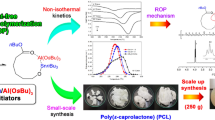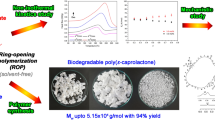Abstract
The ring-opening polymerization (ROP) of ε-caprolactone (CL) initiated by tributyltin alkoxides (n-Bu3SnOR), where R = methyl (Me), ethyl (Et), propyl (Pr), and butyl (Bu), was investigated using density functional theory at B3LYP level with mixed basis set. A coordination–insertion mechanism with two transition states was found for all ROP reactions: (1) starting with a coordination of CL onto Sn center led to a nucleophilic addition of the carbonyl group of CL, (2) followed by the exchange of alkoxide ligand with Sn atom and the ROP of CL was completed through classical acyl-oxygen bond cleavage. The barrier heights of all reactions with different initiators were calculated using potential energy profiles. All ROP reactions initiated with n-Bu3SnOR demonstrated exothermic reaction and the rate-determining step was the first transition state. The ROP of CL with n-Bu3SnOMe has the smallest value of barrier height compared to other reactions. Moreover, the activation energies for all ROP reactions, calculated using the transition state theory with TheRATE program, are in good agreement with available experimental data.





Similar content being viewed by others
References
Albertsson A-C, Varma IK (2003) Recent Developments in ring opening polymerization of lactones for biomedical applications. Biomacromolecules 4(6):1466–1486
Jérôme C, Lecomte P (2008) Recent advances in the synthesis of aliphatic polyesters by ring-opening polymerization. Adv Drug Deliv Rev 60(9):1056–1076
Dechy-Cabaret O, Martin-Vaca B, Bourissou D (2004) Controlled ring-opening polymerization of lactide and glycolide. Chem Rev 104(12):6147–6176
Kricheldorf HR, Sumbel MV, Kreiser-Saunders I (1991) Polylactones. 20. Polymerization of iε-caprolactone with tributyltin derivatives: a mechanistic study. Macromolecules 24(8):1944–1949
Kricheldorf HR, Kreiser-Saunders I, Boettcher C (1995) Polylactones: 31. Sn(II)octoate-initiated polymerization of l-lactide: a mechanistic study. Polymer 36(6):1253–1259
Kricheldorf HR, Kreiser-Saunders I (2000) Polylactones 49: Bu4Sn-initiated polymerizations of ε-caprolactone. Polymer 41(11):3957–3963
Kricheldorf HR, Kreiser-Saunders I, Stricker A (2000) Polylactones 48. SnOct2-Initiated polymerizations of lactide: a mechanistic study. Macromolecules 33(3):702–709
Kricheldorf HR, Hachmann-Thießen H (2004) Polylactones 60: comparison of the reactivity of Bu3SnOEt, Bu2Sn(OEt)2, and BuSn(OEt)3 as initiators of ε-caprolactone. J Macromol Sci 41(4):335–343
Kricheldorf HR, Berl M, Scharnagl N (1988) Poly(lactones) 9. Polymerization mechanism of metal alkoxide initiated polymerizations of lactide and various lactones. Macromolecules 21(2):286–293
Meelua W, Bua-own V, Molloy R, Punyodom W (2012) Comparison of metal alkoxide initiators in the ring-opening polymerization of caprolactone. Adv Mater Res 506:142–145
Kricheldorf HR, Lee S-R, Bush S (1996) Polylactones 36. Macrocyclic polymerization of lactides with cyclic Bu2Sn initiators derived from 1,2-ethanediol, 2-mercaptoethanol, and 1,2-dimercaptoethane. Macromolecules 29(5):1375–1381
von Schenck H, Ryner M, Albertsson A-C, Svensson M (2002) Ring-opening polymerization of lactones and lactides with Sn(IV) and Al(III) initiators. Macromolecules 35(5):1556–1562
Chisholm MH, Delbridge EE (2003) A study of the ring-opening of lactides and related cyclic esters by Ph2SnX2 and Ph3SnX compounds (X = NMe2, OR). New J Chem 27(8):1167–1176
Kalmi M, Lahcini M, Castro P, Lehtonen O, Belfkira A, Leskelä M, Repo T (2004) Tetrakis Sn(IV) alkoxides as novel initiators for living ring-opening polymerization of lactides. J Polym Sci 42(8):1901–1911
Pappalardo D, Annunziata L, Pellecchia C, Biesemans M, Willem R (2007) Ring-opening polymerization of ε-caprolactone by benzylalkoxybis(2,4,6-triisopropylphenyl)tin compounds: observation of the insertion product into the Sn–OMe bond. Macromolecules 40(6):1886–1890
Chisholm MH, Gallucci JC, Krempner C (2007) Ring-opening polymerization of l-lactide by organotin(IV)alkoxides, R2Sn(OPri)2: estimation of the activation parameters. Polyhedron 26(15):4436–4444
Li P, Zerroukhi A, Chen J, Chalamet Y, Jeanmaire T, Xia Z (2009) Synthesis of poly([var epsilon]-caprolactone)-block-poly(n-butyl acrylate) by combining ring-opening polymerization and atom transfer radical polymerization with Ti[OCH2CCl3]4 as difunctional initiator: I. Kinetic study of Ti[OCH2CCl3]4 initiated ring-opening polymerization of [var epsilon]-caprolactone. Polymer 50(5):1109–1117
Meelua W, Molloy R, Meepowpan P, Punyodom W (2012) Isoconversional kinetic analysis of ring-opening polymerization of ε-caprolactone: steric influence of titanium(IV) alkoxides as initiators. J Polym Res 19:1–11
Huang B-H, Lin C-N, Hsueh M-L, Athar T, Lin C-C (2006) Well-defined sterically hindered zinc aryloxides: excellent catalysts for ring-opening polymerization of ε-caprolactone and l-lactide. Polymer 47(19):6622–6629
Eguiburu JL, Fernandez-Berridi MJ, Cossio FP, Roman JS (1999) Ring-opening polymerization of l-lactide initiated by (2-methacryloxy)ethyloxy–aluminum trialkoxides 1. Kinetics. Macromolecules 32(25):8252–8258
Eguiburu JL, Fernandez-Berridi MJ, San Román J (2000) Ring opening polymerisation of l-lactide initiated by oxyethyl methacrylate–aluminium trialkoxides part 2. End groups exchange. Polymer 41(17):6439–6445
Gadzinowski M, Sosnowski S, Slomkowski S (1996) Kinetics of the dispersion ring-opening polymerization of ε-caprolactone initiated with diethylaluminum ethoxide. Macromolecules 29(20):6404–6407
Stjerndahl A, Wistrand AF, Albertsson A-C (2007) Industrial utilization of tin-initiated resorbable polymers: synthesis on a large scale with a low amount of initiator residue. Biomacromolecules 8(3):937–940
Zhang X, MacDonald DA, Goosen MFA, McAuley KB (1994) Mechanism of lactide polymerization in the presence of stannous octoate: the effect of hydroxy and carboxylic acid substances. J Polym Sci Pol Chem 32(15):2965–2970
Kowalski A, Duda A, Penczek S (1998) Kinetics and mechanism of cyclic esters polymerization initiated with tin(II) octoate, 1. Polymerization of ε-caprolactone. Macromol Rapid Commun 19(11):567–572
Storey RF, Taylor AE (1998) Effect of stannous octoate on the composition, molecular weight, and molecular weight distribution of ethylene glycol-initiated poly(ε-caprolactone). J Macromol Sci 35(5):723–750
Kowalski A, Duda A, Penczek S (2000) Mechanism of cyclic ester polymerization initiated with tin(II) octoate 2. Macromolecules fitted with tin(II) alkoxide species observed directly in MALDI-TOF spectra. Macromolecules 33(3):689–695
Lawan N, Muangpil S, Kungwan N, Meepowpan P, Lee VS, Punyodom W (2013) Tin (IV) alkoxide initiator design for poly (d-lactide) synthesis using DFT calculations. Comput Theoret Chem 1020:121–126
Sattayanon C, Kungwan N, Punyodom W, Meepowpan P, Jungsuttiwong S (2013) Theoretical investigation on the mechanism and kinetics of the ring-opening polymerization of ε-caprolactone initiated by tin(II) alkoxides. J Mol Model 19(12):5377–5385
Liu J, Ling J, Li X, Shen Z (2009) Monomer insertion mechanism of ring-opening polymerization of ε-caprolactone with yttrium alkoxide intermediate: a DFT study. J Mol Catal A 300(1–2):59–64
Ling J, Shen J, Hogen-Esch TE (2009) A density functional theory study of the mechanisms of scandium-alkoxide initiated coordination-insertion ring-opening polymerization of cyclic esters. Polymer 50(15):3575–3581
Zhu R, Wang R, Zhang D, Liu C (2009) A density functional theory study on the ring-opening polymerization of d-lactide catalyzed by a bifunctional-thiourea catalyst. Aust J Chem 62(2):157–164
Limwanich W, Meepowpan P, Khunmanee S, Kungwan N, Punyodom W (2014) Effect of tributyltin alkoxides chain length on the ring-opening polymerization of ε-caprolactone: kinetics studies by non-isothermal DSC. Thermochimica Acta (under review)
Frisch MJ, Trucks GW, Schlegel HB, Scuseria GE, Robb MA, Cheeseman JR, Scalmani G, Barone V, Mennucci B, Petersson GA, Nakatsuji H, Caricato M, Li X, Hratchian HP, Izmaylov AF, Bloino J, Zheng G, Sonnenberg JL, Hada M, Ehara M, Toyota K, Fukuda R, Hasegawa J, Ishida M, Nakajima T, Honda Y, Kitao O, Nakai H, Vreven T, Montgomery JA Jr, Peralta JE, Ogliaro F, Bearpark MJ, Heyd J, Brothers EN, Kudin KN, Staroverov VN, Kobayashi R, Normand J, Raghavachari K, Rendell AP, Burant JC, Iyengar SS, Tomasi J, Cossi M, Rega N, Millam NJ, Klene M, Knox JE, Cross JB, Bakken V, Adamo C, Jaramillo J, Gomperts R, Stratmann RE, Yazyev O, Austin AJ, Cammi R, Pomelli C, Ochterski JW, Martin RL, Morokuma K, Zakrzewski VG, Voth GA, Salvador P, Dannenberg JJ, Dapprich S, Daniels AD, Farkas Ö, Foresman JB, Ortiz JV, Cioslowski J, Fox DJ (2004) Gaussian 03, revision C.02. Gaussian Inc, Wallingford
Becke AD (1993) Density-functional thermochemistry. III. The role of exact exchange. J Chem Phys 98(7):5648–5652
Lee C, Yang W, Parr RG (1988) Development of the Colle-Salvetti correlation-energy formula into a functional of the electron density. Phys Rev B 37(2):785–789
Ryner M, Stridsberg K, Albertsson A-C, von Schenck H, Svensson M (2001) Mechanism of ring-opening polymerization of 1,5-dioxepan-2-one and l-lactide with stannous 2-ethylhexanoate. A theoretical study. Macromolecules 34(12):3877–3881
Hratchian HP, Schlegel HB (2004) Accurate reaction paths using a hessian based predictor–corrector integrator. J Chem Phys 120:9918–9924
Hratchian HP, Schlegel HB (2005) Chapter 10: finding minima, transition states, and following reaction pathways on ab initio potential energy surfaces. In: Dykstra CE, Frenking G, Kim KS, Scuseria GE (eds) Theory and applications of Computational chemistry. Elsevier, Amsterdam, pp 195–249
Khanna A, Sudha Y, Pillai S, Rath S (2008) Molecular modeling studies of poly lactic acid initiation mechanisms. J Mol Model 14(5):367–374
Truong TN, Zhang S (2001) VKLab version 1.0. University of Utah, Salt Lake City
Laidler KJ, King MC (1983) Development of transition-state theory. J Phys Chem 87(15):2657–2664
Duncan WT, Bell RL, Truong TN (1998) TheRate: program for ab initio direct dynamics calculations of thermal and vibrational-state-selected rate constants. J Comput Chem 19(9):1039–1052
Dumklang M, Pattawong N, Punyodom W, Meepowpan P, Molloy R, Hoffman M (2009) Novel tin(II) butoxides for use as initiators in the ring-opening polymerisation of e-caprolactone. Chiang Mai J Sci 36(2):136–148
Acknowledgments
The authors wish to thank the National Research University Project under Thailand’s Office of the Higher Education Commission for financial support. W. Limwanich would like to thank the Research Professional Development Project under the Science Achievement Scholarship of Thailand (SAST) for graduate fellowship. Department of Chemistry, Faculty of Science and The Graduate School, Chiang Mai University is also acknowledged.
Author information
Authors and Affiliations
Corresponding author
Electronic supplementary material
Below is the link to the electronic supplementary material.
Rights and permissions
About this article
Cite this article
Sattayanon, C., Sontising, W., Limwanich, W. et al. Effects of alkoxide alteration on the ring-opening polymerization of ε-caprolactone initiated by n-Bu3SnOR: a DFT study. Struct Chem 26, 695–703 (2015). https://doi.org/10.1007/s11224-014-0527-y
Received:
Accepted:
Published:
Issue Date:
DOI: https://doi.org/10.1007/s11224-014-0527-y




